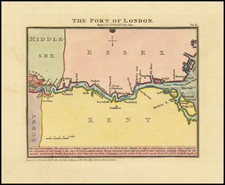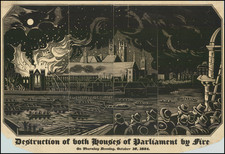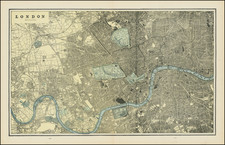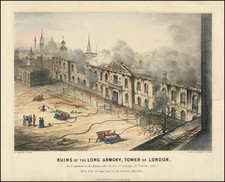John Rocque's First Printed Plan.
This fantastic mid-18th-century plan of what would soon become the Royal Botanic Gardens at Kew was produced by John Rocque, the most famous surveyor and mapmaker of London during that century. The map is oriented with west-northwest at the top. The Thames flows through the image splitting it diagonally, with the plan below and a series of building profiles at the top. Several imposing houses are shown alongside greenhouses, salons, and follies (Merlin's Cave and The Hermitage).
Interestingly, this was Rocque's first printed plan, albeit here in its updated third state:
As has been said, Rocque’s earliest published maps were plans of gardens or estates, including properties owned by the crown and some of the leading nobles in Britain. His first, published by John Bowles in 1734, was of Richmond Gardens, now the Royal Botanical Gardens at Kew. Subsequently, he produced fine plans of Windsor Castle, Kensington Palace, Kew Gardens, Sion House, Chiswick House, and so on, issued under his own imprint. These plans give a clear indication of his working methods. Each is dedicated to an influential or wealthy figure, and the implication is that each figure “honoured” in this way would reward Rocque financially not only for the work itself, but also for the prestige it brought. - Ashley Baynton-Williams, MapForum
History of Kew Gardens
Kew Gardens, one of the most renowned botanical gardens in the world, has a rich history that dates back to the mid-18th century when the area was known as Richmond Gardens. The transformation of Kew began in earnest during this period, shaped significantly by the contributions of the royal family and several notable botanists.
Before 1750, the area that would become Kew Gardens was part of the estates of the Capel family. The transformation into a botanical garden began after Frederick, Prince of Wales, purchased the estate in 1731. Frederick established a garden at Kew, laying the groundwork for its future development. His vision was to create a grand garden that blended formal and natural elements, although much of the garden's significant expansion and scientific emphasis would have occurred after his time.
During these early years, the gardens served primarily as pleasure grounds for the royal family, reflecting the aesthetic tastes of the era with manicured lawns, structured layouts, and a variety of plant species arranged decoratively. The early focus was more on aesthetics and leisure rather than scientific research or botanical significance.
After Frederick's death in 1751, his wife, Princess Augusta, continued to develop the gardens, but the major expansion and transformation into a renowned botanical institution began just after the mid-18th century, notably under her direction starting in 1759.
The view of Merlin’s Cave has replaced the plan of the Hermitage [3a]
John Rocque (circa 1704-1762), an 18th-century surveyor of Huguenot descent, left a profound imprint on the topographical representation of England, particularly through his elaborate maps of London and its surroundings. Despite his significant contributions, his life, both personally and professionally, remains somewhat cloaked in mystery.
Born likely around 1704 or 1705 to French Huguenot parents who migrated to Geneva following the revocation of the Edict of Nantes, Rocque found his calling in England. There, he and his siblings were known to have spent significant parts of their lives. His journey into surveying took off in 1734, with his first recognized work involving a survey of Richmond House and its gardens. This engagement emerged at a fortuitous time when the landscaping and design of the nobility's estates were witnessing renewed interest, which required accurate surveying—a skill Rocque exemplified.
Rocque didn't confine his talents to surveying alone but ventured into printselling, owning a shop near Hyde Park Corner by 1743. This enterprise reflected his energetic nature and the breadth of his ambition, contributing to his reputation for high-quality work, evidenced by the size of his workforce, which included up to ten draughtsmen and engravers at times.
In his later years, Rocque faced adversity, with his shop and entire stock in Whitehall being devastated by fire in 1750. However, his resilience saw him bounce back, and despite several relocations, Rocque maintained his business operations around the Strand area. By the 1750s, his work had taken him to Dublin, where he made substantial contributions in the form of numerous Irish maps and various English county maps.
On the personal front, Rocque married twice but had no known children from either marriage. His first wife was Marthe, whom he married by 1728, and following her death, he married Mary Anne Bew in 1751. Rocque's health began deteriorating towards the end of his life, leading to his death on January 27, 1762. His widow, Mary Anne, continued to manage the business for several years after his demise.









![[Tower of London Fire] Long Room leading to the Brick Tower.](https://storage.googleapis.com/raremaps/img/small/91545.jpg)




